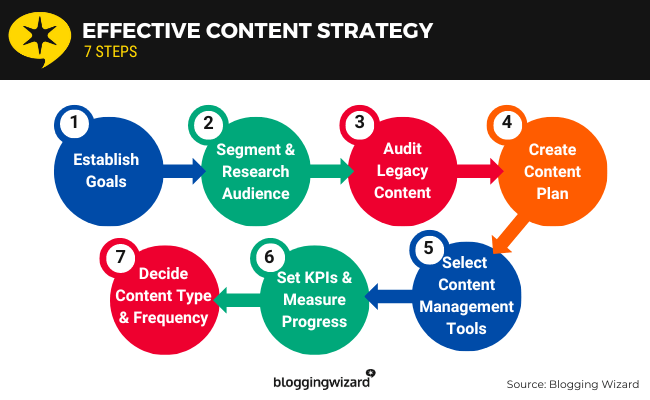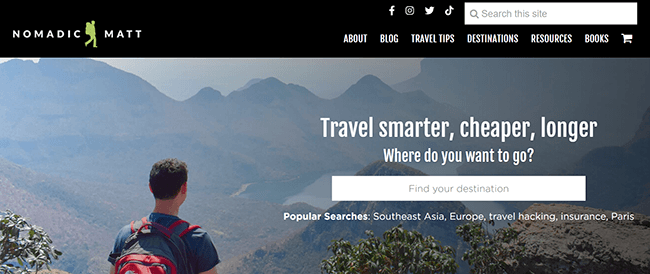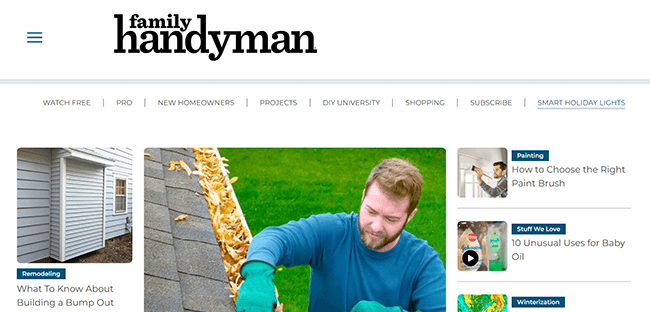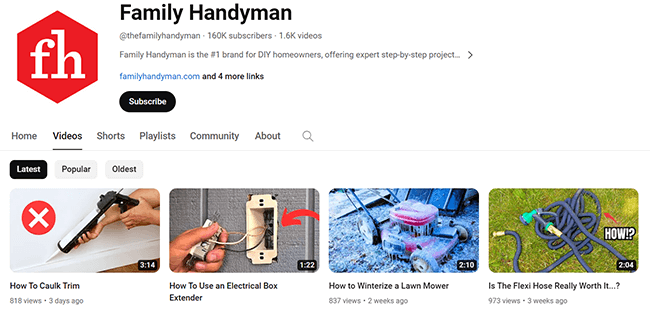What Is A Content Strategy? Definitions, Examples & How To Create One

Content strategy is the compass of your content creation journey. Creating content without a strategy is like being sailing in the ocean with no compass or GPS. You keep sailing – but in the wrong direction.
A lack of content strategy leads to no result from the content. This makes a lot of companies look at content as a waste of time and money. If you want to generate more leads and create a deeper connection with your audience, read on.
What is a content strategy?
A content strategy is the plan, creation, management, and distribution of content based on your specific business goals.
Think of it as the core pillar of your entire content production. With a weak and poorly researched strategy, you won’t be able to meet your business goals and even end up losing money in the process.
Why do you need a content strategy?
Many companies still treat content as nice-to-have instead of a lead-generating asset to boost revenue. The lack of attention leads to a non-existent content marketing strategy with chaotic content without any goal. This creates a vicious cycle: lack of content strategy—no results seen—less attention to content.
What’s more, disorganized content can put off your existing audience, so much so that they could give up on your service or product itself. So, a content strategy is required, not only for generating new business but also to make sure you’re not losing existing ones.
Here are some more reasons why you need a content strategy:
1. Estimate and maximize resources
Money and time investments are two primary concerns that make businesses avoid content. There are already too many moving parts in a business, and content is just seen as an added unnecessary cost.
A content strategy framework narrows down the exact numbers — the definite amount of money you’ll have to invest and resources to allocate. When you see the numbers laid out clearly alongside the potential ROI, content becomes a no-brainer.
For example, without a strategy, you might create ten different blog posts on unrelated topics, making no dent in your organic traffic or revenue. On the other hand, with a content strategy, you might realize that you only need to create five blog posts with an added infographic that can give you considerable results.
2. Create content with an end goal
A content strategy keeps your content aligned with your brand and goals. You don’t waste your resources creating meaningless content.
Erin Balsa, a content marketing expert with more than a decade of experience, shares two key benefits of a documented content strategy:
First, it allows for smarter resource allocation. You’re placing a few bets, working toward them consistently, measuring what’s working best, and reallocating spending toward the highest-impact activities.
Second, it enables the content team and other stakeholders to work together more harmoniously and more efficiently. A good content strategist won’t just map out keywords and identify blog titles—they will think through, and make a plan around, process.
3. Consistent content creation
The impact of your content marketing efforts is only visible after giving it some time.
And that is the difficult part: you need to stay consistent with content even when you’re not seeing any considerable results in the beginning.
Plus, with the pressure of being active on multiple content channels, it’s easy to get overwhelmed and abandon content entirely, especially if you’re a small team. Not only that, it’s also difficult to maintain your brand voice throughout all the mediums if you don’t have a strategy.
This is where the importance of content strategy comes in. First, the strategy gives you specific metrics to refer to, so you can check if you’re on the right path. Second, the content strategy also lays out the content plan in detail. With a filled content calendar, you’re never out of ideas, simplifying the content creation process.
4. Increase your organic traffic
iOS and Google privacy updates continuously make it difficult to run ads profitably. Research shows that ecommerce brands are losing $29 upfront to acquire a new customer. These rising ad costs make it necessary to pay attention to organic audiences to increase profitability.
The problem is: content creation is competitive and you need to create high-quality content consistently to have a chance of establishing your brand. However, a content strategy helps you narrow down your keywords, target audience, and goals. This makes sure you can rank on search engines organically without burning out.
5. Build brand credibility
An ideal content strategy considers your target audience’s problems, needs, and wants before creating a content map. With that, you’re able to publish content that answers your audience’s questions and helps them reach their aspirations. The informative content establishes your credibility and brand authority.
6. Attract leads and increase revenue
Content strategy helps you create a mix of educational content and promotional content, as suited to your niche and business. The educational content primes your potential customers and creates brand awareness. And the promotional content eventually sells your offering.
This balance is only possible with a well-thought-out strategy beforehand. Otherwise, you risk creating an excess of one type of content, ignoring the other.
How to develop a content strategy
Creating a content strategy is as simple as following these 7-step process:
- Establish goals
- Segment and research your audience
- Audit existing content and processes
- Brainstorm content ideas
- Choose your content management tools
- Set KPIs and measure progress
- Decide the content type and frequency

1. Establish goals
Your content strategy is as good as the clarity of your goals. It helps you achieve your business goals, but if the goals are not established properly, the strategy can’t be of help.
Think of it this way: the content strategy is a map to reach your desired location. However, if you put it in the wrong location, you’ll end up at an incorrect place—no matter how good the map is.
Diana Briceño, Head of Content at VEED.IO, shares how important setting goals are, especially for fast-growing remote teams:
Teams are sometimes siloed, and mentions of goals get lost in tens of dozens of Slack channels and Notion docs (especially in the early days). Having conversations with my boss and other team leads is the most important step I take to spot important themes and make a strategy that makes sense for our content and the business.
It sounds simple but in a remote environment, you’re not overhearing your colleagues physically sitting next to you. If you’re not mindful of that, important details will get lost if you solely rely on other people coming to you rather than you going to them.
So, before you start creating your strategy, write down your overarching business goals. Do you want to increase brand awareness or leads for a new product line? Do you want to bring back past customers or consistent organic traffic?
The strategy will differ vastly based on your goals. In fact, in some cases, you might also discover that content isn’t what you need at the moment.
What’s more, the type of content you create later will heavily depend on your goals, too. For example, the content needed to convert customers at the bottom of the sales funnel will differ greatly from the content needed for an unaware audience.
Once you have an idea of where you want to go, create more detailed goals, ideally with numbers and deadlines tied to them, also called SMART goals. For example, instead of saying “We need more newsletter subscribers,” you can say “We need to increase our subscribers by 40% by the end of quarter two.” This gives you a deadline and a specific number to work towards.
2. Segment and research your audience
The core of content is your audience — it’s created for them. Good content speaks to the customers and not at them. This is only possible when you have a clear idea of what your audience wants.
A common mistake is assuming your audience’s problems and needs. Audience research might reveal something entirely new.
Jakub Rudnik, Director of Content Marketing at ActiveCampaign, says:
When developing a content strategy, you must know the pain your customers experience that leads them to your products. This does two things: 1) Identifies topics and pieces of content you should create that will show them how to solve those problems and 2) shows you how to position your product in those conversations.
He also shared his favorite questions to ask customers to get this information:
- What problem is our product solving?
- What did you use to solve this problem before?
- What would you do if our product didn’t exist tomorrow?
- Describe what our product does in one sentence.
You can then create content ideas from the answers you get. For example, if your tool is helping your customers automate a task like email sequences, create a how-to blog post like “How to automate your email sequences.”
He added, “On the SEO side, we validate these responses with keyword data, but we’ve identified many topics that don’t show up in SEO tools by simply talking to customers.”
This is only possible when you’ve clearly defined and segmented your audience. Once you know where your audience is, what they want, and when they want it, you can meet them at the right place and time. This also helps you focus your resources on crucial areas instead of trying to do everything at once.
Your audience segment will also dictate the kind of content you’ll create. If your audience prefers video content, creating blogs will be wasteful. Or, if your audience is present on social media platforms like Instagram, but you’re only creating podcasts and not repurposing them, it’s again of no use.
3. Audit existing content and processes
If you’ve been creating content already, run a content audit to measure its past performance, and what worked (or not).
If certain pieces of content don’t resonate with your audience or business goals, you know what not to include in the new strategy. You might also discover some top-performing content assets to analyze.
Your content strategy should also include dedicated time for content formatting if you need to update past usable content. In the process, keep looking for opportunities to repurpose content and save time.
When doing a content audit, pay attention to the existing content creation process, too. Note down any bottlenecks and areas to improve. This will speed up the new content workflow.
Next, analyze how your competitors are creating content and find gaps to include later.
4. Brainstorm content ideas
Once you know your goals, audience, and competitors, coming up with new content ideas isn’t as difficult.
Start by reviewing your audience’s pressing problems, desires, and needs. Understand opportunities where your product or service is helping them. Your content should bridge the gap between your audience’s current state and how your product/service can solve their problems.
Colin Dougherty, Marketing Director at Zenlytic, suggests:
You need a balance of answering specific questions people are searching for, questions that need to be answered, and the keywords around that subject. And then write educational pieces around that keyword.
Once you have a list of a wide range of ideas, start categorizing them into different topic clusters. Keep refining them further to add more details where needed.
5. Choose your content management tools
Content management has a lot of different areas involved – from content creation and publishing to reporting and analytics. With so many aspects, it gets complex quickly.
To avoid running into difficulties and confusion later on, set workflows and systems in place from the get-go.
While you don’t need to invest in an expensive tool, you still need to set up a system with your team on board. You can choose to use just a Google Spreadsheet, Notion, or a dedicated content management system (CMS).
6. Set KPIs and measure progress
Your content strategies should keep evolving based on your audience’s response.
Set Key Performance Indicators (KPIs) while creating the strategy so that you know what to look for when analyzing results. These KPIs will depend on your goals. For example, if your goal is to reach new customers, the number of new website sessions or followers can be a good indicator.
This also protects you from getting caught up in chasing vanity metrics like likes and followers at the start. While likes and comments can give you an insight into how engaged your audience is, it’s not the most important factor. With set KPIs, you’ll be looking at the right areas like sales and new leads instead of judging the performance only by likes and comments.
If your audience is primarily on social media, here are some important goals to consider, apart from likes and followers.
7. Decide the content type and frequency
From infographics and blog posts to podcasts and videos, there are a lot of content types that you can choose to create. However, this shouldn’t be a shot in the dark.
The best content type is what your audience prefers and readily consumes. So, review your audience research data and the goals you want to achieve.
You might also have to choose more than one content type to cater to different audience segments and meet your goals. But having it laid down in your strategy is the important step.
Next, consider the resources you have available, too. If you want to create a mix of blog posts and video content but don’t have the resources to produce videos currently, you can look at outsourcing or even pausing it. If you can create content only once a week, include it in your strategy. A consistent frequency is more important than the volume of content.
Content strategy examples
Here are some examples of brands that created a winning content strategy to create a loyal audience base:
1. Food Babe
Food Babe started as a blog based on research and insights into food safety and ingredients. The blog’s founder, Vani Hari, later launched her line of food products and supplements that adhere to industry standards and her principles. She was able to do that with the existing blog’s influence to market and sell the new products.

The blog was able to attain this level of success because of an excellent content strategy. Here’s a breakdown of the essential components:
- Clear goal: Food Babe had a clear goal and message – to raise awareness about food ingredients and their effects.
- Audience: The blog was able to find a niche audience interested in the same subject. The content pieces spoke directly to them, addressing their fears and questions. The success is evident from the audience interaction via comments and social shares.
- Content type: The blog was started in 2011 when text was the primary medium consumed. It included research reports and in-depth blogs. However, as the blog audience evolved, the blog launched a YouTube channel to create video content, too.
- Consistency: The blog has maintained a publishing cadence, publishing multiple times a month. This consistency gives the audience something to look forward to.
- Unique point of view: This is what differentiates the blog from others. Food Babe started by exposing hidden ingredients and industry practices that were affecting all its readers.
2. Nomadic Matt
Nomadic Matt began as a travel blog offering budget travel tips and destination guides. The blog eventually added paid courses and books, too. Like Food Babe, Nomadic Matt also has a well-defined audience and a clear goal of helping readers plan affordable trips.

The content type created is primarily in-depth guides, personal experiences, and travel tips – all of which are the primary medium consumed by travelers.
The audience research is visible in the content topics as the blog focuses on budget-friendly trips. If they created luxury travel tips for their target audience of budget travelers, the blog wouldn’t have worked.
3. The Family Handyman
The Family Handyman is a DIY and home improvement blog. It offers actionable and practical home improvement guidance and techniques.

The blog has a core audience of homeowners and DIY enthusiasts. It has evolved and included topics that its audience wanted to see, including a wide range of projects.
The blog chose its content type practically: they have a YouTube channel to show the how-tos, complementing the videos with a detailed guide the audience can follow as a checklist.

Elements of a great content strategy
Now that you know how to create a content strategy and how brands are leveraging it, here’s a checklist of the most crucial elements:
1. Audience-first approach: Branded content routinely gets lost in nothingness online. The common element of such content is the domination of the brand throughout the pieces. Your content strategy should put your audience at the forefront to resonate with them.
2. Unique point of view: Include a unique point of view or a strategic narrative that your creators or writers can weave throughout your content. This sets you apart from your competitors, communicates brand values, and connects deeply with your audience.
3. Editorial guidelines: If you have a team for content, a new team member could mean a change in brand voice and communications. This occurs more often if you’re outsourcing the process.
To avoid such content mistakes, create well-documented and detailed editorial guidelines including your brand voice, formatting styles, and more. You can even judge the effectiveness of content strategy by how easily a new team member understands the workflow.
This way, you’ll have consistent brand messaging and communication in all different pieces and channels of content.
4. SEO integration: Search engine optimization (SEO) isn’t just stuffing keywords. Think of it as optimizing for your readers. You could create the most thorough piece of content, but if it’s not well-optimized for your readers, you’ll have a difficult time ranking on search engines.
How can they find your content easily? What are the keywords they’re using? How can you create attention-grabbing headings? What should be the content structure? Answering these questions gives your content a fair chance to rank organically and increase website traffic.
5. Promotion plan: Content strategy doesn’t end at the creation. You need to allocate a budget for the end distribution and promotion, too. This includes the budget for content repurposing to fit different channels, influencer marketing, and more.
The promotion plan maximizes the impact of all your content pieces, increasing the ROI of your content.
6. Content calendar: Content calendar gives you an overview of an entire month, quarter, or year, to help you plan. Without this foresight, you risk missing important holidays or events, and end up creating rushed content.
For example, for a Black Friday Sale, you need to start the content production a month or two in advance. The content calendar helps you set deadlines, assign work on time, and narrow down topics. It also gives a bird’s eye view of the production to your team members.
Content strategy FAQ
Keep adjusting your content strategy for the best results
Content strategy evaluation is as important as its creation. A successful strategy is the result of a lot of trial and error. So, once you have the first strategy plan, expect to evolve and iterate as the audience reacts. You might want to double down on what’s working and eliminate another thing.
Here’s a list of engaging types of content to choose from. Or, if you’ve found a lot of content pieces to repurpose, here’s a guide on how to start.
